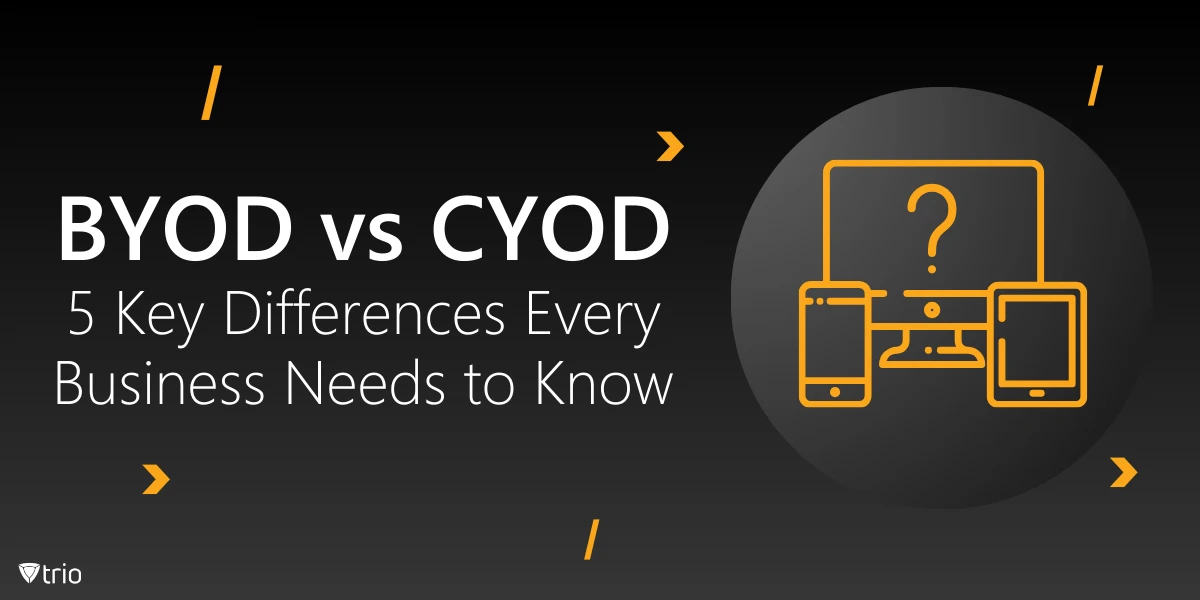As businesses become increasingly dependent on mobile devices, selecting the right strategy becomes ever more critical to the organization’s success and sustainability. In the debate between BYOD vs CYOD vs COPE models on the table, each presents a distinct balance of flexibility, security, and control, allowing businesses to choose the approach that best aligns with their operational needs and priorities.
As remote work expands, finding the right strategy can significantly impact productivity and data protection. This blog explores the key differences between BYOD and CYOD to offer insights to help you make informed decisions for your company’s future.
Overview of BYOD: Flexibility at a Cost?
The bring your own device (BYOD) model has become popular among businesses aiming to reduce costs. Essentially, it allows employees to use their personal devices for work, offering flexibility that many people love. It also saves companies money by cutting down on hardware expenses. Actually, according to CBS News, 67 percent of employees use personal devices at work, whether or not their company has a formal BYOD policy in place.
However, this freedom comes with a security risk. Personal devices aren’t always equipped with the same level of protection as company-owned hardware. A strong BYOD policy is crucial to minimize vulnerabilities, but even with that in place, managing multiple device types and ensuring compliance with company regulations can be tricky. For example, what happens when an employee’s phone is lost or stolen? Companies must be prepared to handle these challenges.

Overview of CYOD: The Middle Ground
Meaning of CYOD is Choose Your Own Device, where employees choose from a list of approved devices. This approach offers a nice balance: employees still get some flexibility, but employers maintain control over the types of devices used.
This model gives companies greater control over security, as they can ensure that all devices meet their standards. Plus, it simplifies IT management—with fewer device types, troubleshooting is much easier. Compliance is also easier to maintain since all devices follow the same guidelines.
Employees can still personalize their experience by selecting a device that suits them from the pre-approved list, but with more security oversight. So, you get flexibility with a safety net!

5 Key Differences Between BYOD and CYOD
Now that we’ve broken down BYOD and CYOD, let’s look at the key differences. Both models have their benefits and risks, so understanding how they stack up in crucial areas like security, costs, and employee satisfaction can help you decide which is best for your business.
Security
When it comes to data security, BYOD has many weak points. Unmanaged personal devices can be a risk if they are lost or stolen, leading to data breaches. So one BYOD challenge is often protecting sensitive information across a wide range of devices. In contrast, CYOD offers more control, with company-approved devices allowing tighter security measures and reducing potential risks.
Costs
If we look at BYOD vs CYOD pros and cons, BYOD seems cheaper upfront since employees bring their own devices. However, hidden costs like troubleshooting and support can add up. With CYOD, device provisioning is more expensive initially, but fewer unexpected costs emerge down the line, making it a safer long-term financial choice.
Employee Satisfaction
BYOD tends to win in this department because employees love using their personal enabled devices—after all, it’s what they’re most comfortable with. In contrast, CYOD offers a middle ground; employees still get device choices, but from a limited, company-approved list. Satisfaction remains high, though not as flexible as BYOD.
IT Management
BYOD can cause headaches for IT teams. With so many types of devices in the mix, troubleshooting and updates can be tough. Managing everything through mobile device management (MDM) software helps but doesn’t solve all the issues. With CYOD, IT teams have fewer device types to manage, making everything smoother and more efficient.
Compliance
Ensuring compliance can be tricky in a BYOD setup, especially when personal applications mix with company data. Tracking and enforcing regulatory requirements can be difficult. With CYOD, compliance is easier, thanks to pre-configured devices that meet company standards from the start. This means fewer legal headaches for your business.
Which Strategy Suits Your Business?
Choosing between BYOD and CYOD depends on your business’s specific needs. For industries like healthcare or finance, the COPE model (Company Owned, Personally Enabled) or even a stricter approach can help maintain tight control over security and compliance. These sectors benefit more from CYOD because regulatory requirements demand more oversight.
However, the benefits of BYOD can’t be ignored for smaller businesses. If your company has a limited IT budget or is part of a more flexible industry, BYOD might make sense. It offers employees the freedom to use devices they already own while keeping costs low.
Ultimately, assessing your industry’s standards and your company’s size will guide you in deciding which strategy works best. For many, a hybrid approach, with company-approved MDM solutions, balances security and flexibility perfectly.
Practical Tips for Implementing Either Policy
Whether you choose BYOD or CYOD policy, there are a few practical steps to ensure success. Start by creating clear usage policies that outline device management, data security, and compliance expectations. For COPE devices, define how personal use is balanced with work requirements.
Implementing strong MDM solutions is crucial for both strategies, as it helps manage devices and enforce security protocols. This ensures your company can protect sensitive data, regardless of the policy in place.
Finally, offer employee training on security best practices. Educating staff on how to recognize threats, protect their devices, and follow company guidelines goes a long way in minimizing risks and maintaining a secure work environment.
How MDM Works With BYOD and CYOD
Mobile Device Management (MDM) plays a critical role in ensuring security and efficiency for both BYOD and CYOD models. With BYOD, MDM helps secure personal devices accessing company data by enforcing policies such as encryption, password protection, and remote wiping in case of loss or theft. For CYOD, MDM ensures that choose your own device systems are standardized and compliant, making it easier for IT to manage and secure devices across the company.
Ready to simplify your mobile device management? Try Trio’s free demo to see how MDM can work for your business.
Conclusion: Weighing Flexibility Against Control
In the debate between BYOD and CYOD, it’s all about finding the right balance. CYOD means more control and security, while BYOD offers greater flexibility. Depending on your industry’s needs, whether you prioritize COPE security or budget-friendly flexibility, the right choice aligns with your company’s goals.
Ultimately, both models can benefit from strong device management. Consult with an MDM provider to simplify security and ensure compliance—an essential step to smooth operations, no matter which path you choose.
Know about news
in your inbox
Our newsletter is the perfect way to stay informed about the latest updates,
features, and news related to our mobile device management software.
Subscribe today to stay in the know and get the most out of your mobile
devices with our MDM solution app.
Recent Posts

Erase the Risk: Protect with Zero Standing Privileges
Learn how zero standing privileges eliminate persistent access rights, enhance data security and reduce the risk of unauthorized access.

Understanding Access Control Types in Cybersecurity w/ Examples
Thorough understanding of access control types & the knowledge to make informed decisions about implementing security measures in your organization.

Cloud Data Protection: Safeguarding Information in the Cloud
Learn essential strategies for robust cloud data protection, exploring tools, best practices, and policies that safeguard sensitive information.





